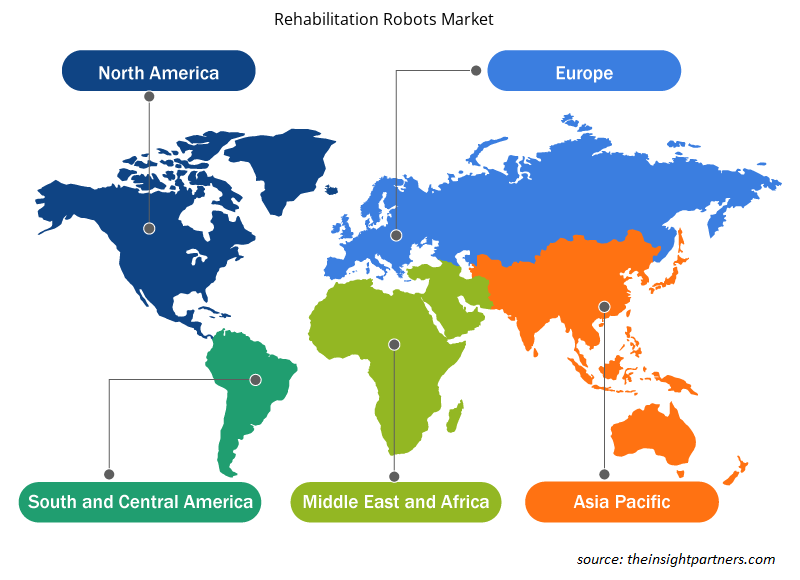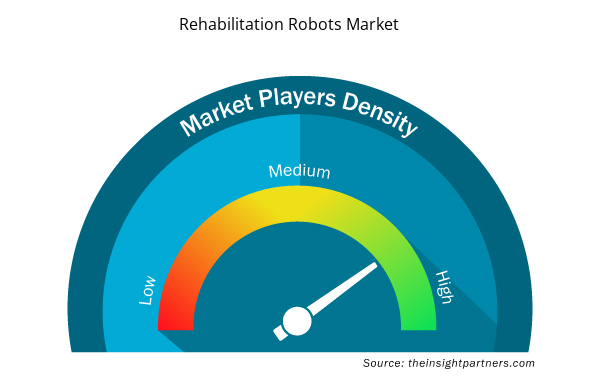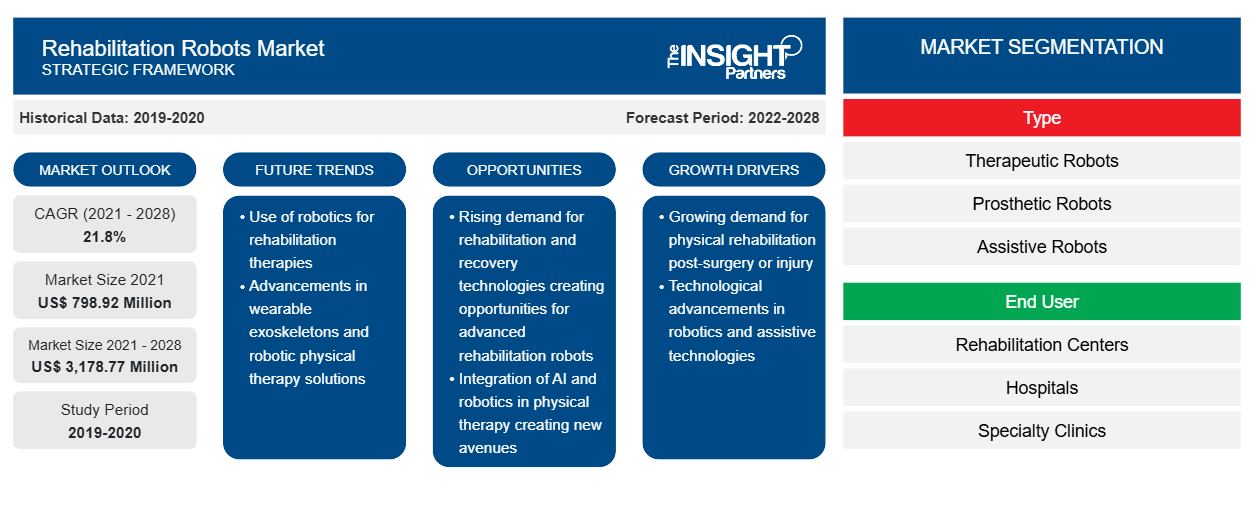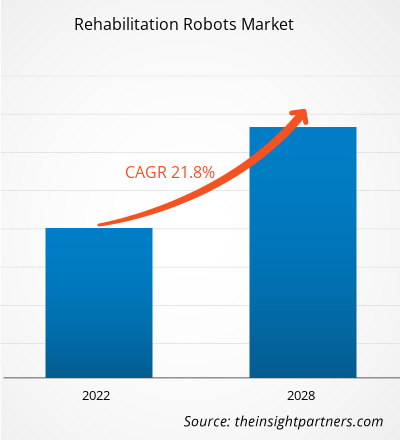El mercado de robots de rehabilitación se valoró en US$ 798,92 millones en 2021 y se proyecta que alcance los US$ 3.178,77 millones en 2028; se espera que crezca a una CAGR del 21,8% entre 2021 y 2028.
Los robots de rehabilitación se utilizan en el proceso de recuperación de pacientes discapacitados que les permite ponerse de pie, mantener el equilibrio y caminar. Estos robots deben seguir el ritmo de los humanos y sus movimientos; por lo tanto, al fabricar la máquina, los fabricantes deben asegurarse de que sea coherente con el progreso del paciente. Se espera que el mercado de robots de rehabilitación experimente un crecimiento significativo en los próximos años debido a factores como el aumento de la población geriátrica, los accidentes cerebrovasculares y el entrenamiento asistido por robots en terapia de rehabilitación. Sin embargo, el alto costo de los dispositivos obstaculiza el crecimiento del mercado.
Perspectivas del mercado
Personalice este informe según sus necesidades
Obtendrá personalización en cualquier informe, sin cargo, incluidas partes de este informe o análisis a nivel de país, paquete de datos de Excel, así como también grandes ofertas y descuentos para empresas emergentes y universidades.
- Obtenga las principales tendencias clave del mercado de este informe.Esta muestra GRATUITA incluirá análisis de datos, desde tendencias del mercado hasta estimaciones y pronósticos.
Aumento de la población geriátrica, accidentes cerebrovasculares y entrenamiento asistido por robot en terapia de rehabilitación
Con el crecimiento de la investigación relacionada con la robótica de rehabilitación, la fabricación y el despliegue de robots de rehabilitación terapéutica están aumentando en todo el mundo. Japón y China se encuentran entre los países de Asia y el Pacífico con una gran población de ancianos; estos países, así como otras naciones en desarrollo de la región, están presenciando los avances en tecnología médica. Según el Ministerio de Asuntos Internos y Comunicaciones, aproximadamente 35,2 millones de personas en Japón tenían 65 años o más en 2017, y se prevé que esta cifra aumente a 36,2 millones para 2020. Por lo tanto, las principales empresas del sector de la salud están dispuestas a invertir en el desarrollo de tecnologías avanzadas para brindar atención a los residentes mayores de la región. Por lo tanto, el aumento de la población de ancianos y la creciente prevalencia de accidentes cerebrovasculares, que dejan a las personas inmóviles, se encuentran entre los factores significativos que impulsan la demanda de robots de rehabilitación.
La terapia de rehabilitación robótica se utiliza para ofrecer entrenamiento de alta intensidad a pacientes que sufren trastornos motores causados por enfermedades de la médula espinal o accidentes cerebrovasculares. Los accidentes cerebrovasculares son una de las principales causas de discapacidad grave a largo plazo en los EE. UU., según los Centros para el Control y la Prevención de Enfermedades (CDC). La fatiga, la hemiparesia y la dificultad para caminar son algunos de los efectos de un accidente cerebrovascular. Además, los robots de rehabilitación brindan entrenamiento personalizado, orientado a tareas, prolongado, intensivo, estandarizado y reproducible a pacientes afectados por accidentes cerebrovasculares u otras lesiones cerebrales no progresivas. Por lo tanto, la creciente demanda de servicios de atención médica mejores y más rápidos impulsa el crecimiento del mercado general de robots de rehabilitación.
Tipo de información
Según el tipo, el mercado de robots de rehabilitación se segmenta en robots terapéuticos, robots de asistencia, robots con exoesqueleto y robots protésicos. El segmento de robots con exoesqueleto tuvo la mayor participación del mercado en 2021 y se prevé que registre la CAGR más alta durante el período de pronóstico.
Usuario final
Según el usuario final, el mercado de robots de rehabilitación se segmenta en hospitales, centros de rehabilitación y clínicas especializadas. El segmento de centros de rehabilitación tuvo la mayor participación del mercado en 2021 y se estima que registrará la CAGR más alta durante el período de pronóstico.
Los actores que operan en el mercado de robots de rehabilitación han estado adoptando principalmente la estrategia de innovación de productos para satisfacer la cambiante demanda de los clientes en todo el mundo, lo que también les permite mantener su marca a nivel mundial.
Perspectivas regionales del mercado de robots de rehabilitación
Los analistas de Insight Partners han explicado detalladamente las tendencias y los factores regionales que influyen en el mercado de robots de rehabilitación durante el período de pronóstico. Esta sección también analiza los segmentos y la geografía del mercado de robots de rehabilitación en América del Norte, Europa, Asia Pacífico, Oriente Medio y África, y América del Sur y Central.

- Obtenga datos regionales específicos para el mercado de robots de rehabilitación
Alcance del informe de mercado de robots de rehabilitación
| Atributo del informe | Detalles |
|---|---|
| Tamaño del mercado en 2021 | US$ 798,92 millones |
| Tamaño del mercado en 2028 | US$ 3.178,77 millones |
| CAGR global (2021-2028) | 21,8% |
| Datos históricos | 2019-2020 |
| Período de pronóstico | 2022-2028 |
| Segmentos cubiertos | Por tipo
|
| Regiones y países cubiertos | América del norte
|
| Líderes del mercado y perfiles de empresas clave |
|
Densidad de actores del mercado de robots de rehabilitación: comprensión de su impacto en la dinámica empresarial
El mercado de robots de rehabilitación está creciendo rápidamente, impulsado por la creciente demanda de los usuarios finales debido a factores como la evolución de las preferencias de los consumidores, los avances tecnológicos y una mayor conciencia de los beneficios del producto. A medida que aumenta la demanda, las empresas amplían sus ofertas, innovan para satisfacer las necesidades de los consumidores y aprovechan las tendencias emergentes, lo que impulsa aún más el crecimiento del mercado.
La densidad de actores del mercado se refiere a la distribución de las empresas o firmas que operan dentro de un mercado o industria en particular. Indica cuántos competidores (actores del mercado) están presentes en un espacio de mercado determinado en relación con su tamaño o valor total de mercado.
Las principales empresas que operan en el mercado de robots de rehabilitación son:
- Corporación de laboratorios Bionik
- Compañía Ciberdyne Inc.
- Exo
- Bionics Holdings Inc
- Rewalk Robotics Ltd
Descargo de responsabilidad : Las empresas enumeradas anteriormente no están clasificadas en ningún orden particular.

- Obtenga una descripción general de los principales actores clave del mercado de robots de rehabilitación
Por tipo
- Robots con exoesqueleto
- Robots terapéuticos
- Robots de asistencia
- Robots protésicos
Usuario final
- Centros de rehabilitación
- Hospitales
- Clínicas de especialidades
Por geografía
- América del norte
- A NOSOTROS
- Canadá
- México
- Europa
- Reino Unido
- Alemania
- Francia
- Italia
- España
- Resto de Europa
- Asia Pacífico
- Porcelana
- Japón
- India
- Australia
- Corea del Sur
- Resto de Asia Pacífico
- Oriente Medio y África
- Emiratos Árabes Unidos
- Arabia Saudita
- Sudáfrica
- Resto de Oriente Medio y África
- América del Sur y Central
- Brasil
- Argentina
- Resto de América del Sur y Central
Perfiles de empresas
- Corporación de laboratorios Bionik
- Compañía Ciberdyne Inc.
- Ekso Bionics Holdings Inc
- Rewalk Robotics Ltd
- Agricultura Hocoma
- Compañía de robótica de rehabilitación limitada
- Kinova Inc
- Rex Bionics Ltd
- Corporación Toyota Motor
- Myomo Inc
- Análisis histórico (2 años), año base, pronóstico (7 años) con CAGR
- Análisis PEST y FODA
- Tamaño del mercado Valor/volumen: global, regional, nacional
- Industria y panorama competitivo
- Conjunto de datos de Excel



Report Coverage
Revenue forecast, Company Analysis, Industry landscape, Growth factors, and Trends

Segment Covered
This text is related
to segments covered.

Regional Scope
North America, Europe, Asia Pacific, Middle East & Africa, South & Central America

Country Scope
This text is related
to country scope.
Preguntas frecuentes
Bionik Laboratories Corporation, Cyberdyne Inc., Ekso Bionics Holdings Inc, Rewalk Robotics Ltd, Hocoma Ag, Rehab-robotics Company Limited, Kinova Inc, Rex Bionics Ltd, Toyota Motor Corporation, Myomo Inc among Others. are some of the major players in the Rehabilitation Robots market.
Rehabilitation robots assist handicapped people in regaining their ability to stand, balance, and walk. Because these robots must keep up with a human's movement, the machine's designers must ensure that the machine will be consistent with the patient's development.
The growth of the market is attributed to the Factors driving the market growth include the rise in geriatric population, stroke and robot-assisted training in rehabilitation therapy. However, high cost of the devices to hinder the market growth.
Trends and growth analysis reports related to Life Sciences : READ MORE..
The List of Companies - Rehabilitation Robots Market
- Bionik Laboratories Corporation
- Cyberdyne Inc.
- Ekso
- Bionics Holdings Inc
- Rewalk Robotics Ltd
- Hocoma Ag
- Rehab-robotics Company Limited
- Kinova Inc, Rex Bionics Ltd
- Toyota Motor Corporation
- Myomo Inc.
The Insight Partners performs research in 4 major stages: Data Collection & Secondary Research, Primary Research, Data Analysis and Data Triangulation & Final Review.
- Data Collection and Secondary Research:
As a market research and consulting firm operating from a decade, we have published and advised several client across the globe. First step for any study will start with an assessment of currently available data and insights from existing reports. Further, historical and current market information is collected from Investor Presentations, Annual Reports, SEC Filings, etc., and other information related to company’s performance and market positioning are gathered from Paid Databases (Factiva, Hoovers, and Reuters) and various other publications available in public domain.
Several associations trade associates, technical forums, institutes, societies and organization are accessed to gain technical as well as market related insights through their publications such as research papers, blogs and press releases related to the studies are referred to get cues about the market. Further, white papers, journals, magazines, and other news articles published in last 3 years are scrutinized and analyzed to understand the current market trends.
- Primary Research:
The primarily interview analysis comprise of data obtained from industry participants interview and answers to survey questions gathered by in-house primary team.
For primary research, interviews are conducted with industry experts/CEOs/Marketing Managers/VPs/Subject Matter Experts from both demand and supply side to get a 360-degree view of the market. The primary team conducts several interviews based on the complexity of the markets to understand the various market trends and dynamics which makes research more credible and precise.
A typical research interview fulfils the following functions:
- Provides first-hand information on the market size, market trends, growth trends, competitive landscape, and outlook
- Validates and strengthens in-house secondary research findings
- Develops the analysis team’s expertise and market understanding
Primary research involves email interactions and telephone interviews for each market, category, segment, and sub-segment across geographies. The participants who typically take part in such a process include, but are not limited to:
- Industry participants: VPs, business development managers, market intelligence managers and national sales managers
- Outside experts: Valuation experts, research analysts and key opinion leaders specializing in the electronics and semiconductor industry.
Below is the breakup of our primary respondents by company, designation, and region:

Once we receive the confirmation from primary research sources or primary respondents, we finalize the base year market estimation and forecast the data as per the macroeconomic and microeconomic factors assessed during data collection.
- Data Analysis:
Once data is validated through both secondary as well as primary respondents, we finalize the market estimations by hypothesis formulation and factor analysis at regional and country level.
- Macro-Economic Factor Analysis:
We analyse macroeconomic indicators such the gross domestic product (GDP), increase in the demand for goods and services across industries, technological advancement, regional economic growth, governmental policies, the influence of COVID-19, PEST analysis, and other aspects. This analysis aids in setting benchmarks for various nations/regions and approximating market splits. Additionally, the general trend of the aforementioned components aid in determining the market's development possibilities.
- Country Level Data:
Various factors that are especially aligned to the country are taken into account to determine the market size for a certain area and country, including the presence of vendors, such as headquarters and offices, the country's GDP, demand patterns, and industry growth. To comprehend the market dynamics for the nation, a number of growth variables, inhibitors, application areas, and current market trends are researched. The aforementioned elements aid in determining the country's overall market's growth potential.
- Company Profile:
The “Table of Contents” is formulated by listing and analyzing more than 25 - 30 companies operating in the market ecosystem across geographies. However, we profile only 10 companies as a standard practice in our syndicate reports. These 10 companies comprise leading, emerging, and regional players. Nonetheless, our analysis is not restricted to the 10 listed companies, we also analyze other companies present in the market to develop a holistic view and understand the prevailing trends. The “Company Profiles” section in the report covers key facts, business description, products & services, financial information, SWOT analysis, and key developments. The financial information presented is extracted from the annual reports and official documents of the publicly listed companies. Upon collecting the information for the sections of respective companies, we verify them via various primary sources and then compile the data in respective company profiles. The company level information helps us in deriving the base number as well as in forecasting the market size.
- Developing Base Number:
Aggregation of sales statistics (2020-2022) and macro-economic factor, and other secondary and primary research insights are utilized to arrive at base number and related market shares for 2022. The data gaps are identified in this step and relevant market data is analyzed, collected from paid primary interviews or databases. On finalizing the base year market size, forecasts are developed on the basis of macro-economic, industry and market growth factors and company level analysis.
- Data Triangulation and Final Review:
The market findings and base year market size calculations are validated from supply as well as demand side. Demand side validations are based on macro-economic factor analysis and benchmarks for respective regions and countries. In case of supply side validations, revenues of major companies are estimated (in case not available) based on industry benchmark, approximate number of employees, product portfolio, and primary interviews revenues are gathered. Further revenue from target product/service segment is assessed to avoid overshooting of market statistics. In case of heavy deviations between supply and demand side values, all thes steps are repeated to achieve synchronization.
We follow an iterative model, wherein we share our research findings with Subject Matter Experts (SME’s) and Key Opinion Leaders (KOLs) until consensus view of the market is not formulated – this model negates any drastic deviation in the opinions of experts. Only validated and universally acceptable research findings are quoted in our reports.
We have important check points that we use to validate our research findings – which we call – data triangulation, where we validate the information, we generate from secondary sources with primary interviews and then we re-validate with our internal data bases and Subject matter experts. This comprehensive model enables us to deliver high quality, reliable data in shortest possible time.


 Obtenga una muestra gratuita de este informe
Obtenga una muestra gratuita de este informe